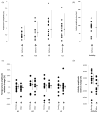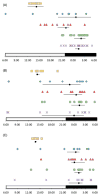Thoracic surface temperature rhythms as circadian biomarkers for cancer chronotherapy
- PMID: 24397341
- PMCID: PMC4221267
- DOI: 10.3109/07420528.2013.864301
Thoracic surface temperature rhythms as circadian biomarkers for cancer chronotherapy
Abstract
The disruption of the temperature circadian rhythm has been associated with cancer progression, while its amplification resulted in cancer inhibition in experimental tumor models. The current study investigated the relevance of skin surface temperature rhythms as biomarkers of the Circadian Timing System (CTS) in order to optimize chronotherapy timing in individual cancer patients. Baseline skin surface temperature at four sites and wrist accelerations were measured every minute for 4 days in 16 patients with metastatic gastro-intestinal cancer before chronotherapy administration. Temperature and rest-activity were recorded, respectively, with wireless skin surface temperature patches (Respironics, Phillips) and an actigraph (Ambulatory Monitoring). Both variables were further monitored in 10 of these patients during and after a 4-day course of a fixed chronotherapy protocol. Collected at baseline, during and after therapy longitudinal data sets were processed using Fast Fourier Transform Cosinor and Linear Discriminant Analyses methods. A circadian rhythm was statistically validated with a period of 24 h (p < 0.05) for 49/61 temperature time series (80.3%), and 15/16 rest-activity patterns (93.7%) at baseline. However, individual circadian amplitudes varied from 0.04 °C to 2.86 °C for skin surface temperature (median, 0.72 °C), and from 16.6 to 146.1 acc/min for rest-activity (median, 88.9 acc/min). Thirty-nine pairs of baseline temperature and rest-activity time series (75%) were correlated (r > |0.7|; p < 0.05). Individual circadian acrophases at baseline were scattered from 15:18 to 6:05 for skin surface temperature, and from 12:19 to 15:18 for rest-activity, with respective median values of 01:10 (25-75% quartiles, 22:35-3:07) and 14:12 (13:14-14:31). The circadian patterns in skin surface temperature and rest-activity persisted or were amplified during and after fixed chronotherapy delivery for 5/10 patients. In contrast, transient or sustained disruption of these biomarkers was found for the five other patients, as indicated by the lack of any statistically significant dominant period in the circadian range. No consistent correlation (r < |0.7|, p ≥ 0.05) was found between paired rest-activity and temperature time series during fixed chronotherapy delivery. In conclusion, large inter-patient differences in circadian amplitudes and acrophases of skin surface temperature were demonstrated for the first time in cancer patients, despite rather similar rest-activity acrophases. The patient-dependent coupling between both CTS biomarkers, and its possible alteration on a fixed chronotherapy protocol, support the concept of personalized cancer chronotherapy.
Conflict of interest statement
The authors report no conflicts of interest. Support for this project was provided by ARTBC International and Braun France.
Figures





Similar articles
-
Relevance of a Mobile Internet Platform for Capturing Inter- and Intrasubject Variabilities in Circadian Coordination During Daily Routine: Pilot Study.J Med Internet Res. 2018 Jun 11;20(6):e204. doi: 10.2196/jmir.9779. J Med Internet Res. 2018. PMID: 29704408 Free PMC article.
-
The circadian rest-activity rhythm, a potential safety pharmacology endpoint of cancer chemotherapy.Int J Cancer. 2014 Jun 1;134(11):2717-25. doi: 10.1002/ijc.28587. Epub 2013 Nov 25. Int J Cancer. 2014. PMID: 24510611
-
The circadian timing system in clinical oncology.Ann Med. 2014 Jun;46(4):191-207. doi: 10.3109/07853890.2014.916990. Ann Med. 2014. PMID: 24915535 Review.
-
Relevance of internal time and circadian robustness for cancer patients.BMC Cancer. 2016 Apr 21;16:285. doi: 10.1186/s12885-016-2319-9. BMC Cancer. 2016. PMID: 27102330 Free PMC article.
-
Therapeutic implications of circadian rhythms in cancer patients.Novartis Found Symp. 2000;227:119-36; discussion 136-42. doi: 10.1002/0470870796.ch8. Novartis Found Symp. 2000. PMID: 10752068 Review.
Cited by
-
Multicentre, interventional, single-arm study protocol of telemonitored circadian rhythms and patient-reported outcomes for improving mFOLFIRINOX safety in patients with pancreatic cancer (MultiDom, NCT04263948).BMJ Open. 2023 Jun 7;13(6):e069973. doi: 10.1136/bmjopen-2022-069973. BMJ Open. 2023. PMID: 37286324 Free PMC article.
-
A Tangled Threesome: Circadian Rhythm, Body Temperature Variations, and the Immune System.Biology (Basel). 2021 Jan 18;10(1):65. doi: 10.3390/biology10010065. Biology (Basel). 2021. PMID: 33477463 Free PMC article. Review.
-
Translating around the clock: Multi-level regulation of post-transcriptional processes by the circadian clock.Cell Signal. 2021 Apr;80:109904. doi: 10.1016/j.cellsig.2020.109904. Epub 2020 Dec 25. Cell Signal. 2021. PMID: 33370580 Free PMC article. Review.
-
Circadian disruption and cancer- and treatment-related symptoms.Front Oncol. 2022 Oct 28;12:1009064. doi: 10.3389/fonc.2022.1009064. eCollection 2022. Front Oncol. 2022. PMID: 36387255 Free PMC article. Review.
-
Circadian rhythms and breast cancer: from molecular level to therapeutic advancements.J Cancer Res Clin Oncol. 2024 Sep 12;150(9):419. doi: 10.1007/s00432-024-05917-w. J Cancer Res Clin Oncol. 2024. PMID: 39266868 Free PMC article. Review.
References
-
- Ahowesso C, Li XM, Zampera S, et al. Sex and dosing-time dependencies in irinotecan-induced circadian disruption. Chronobiol Int. 2011;28:458–70. - PubMed
-
- Bouchahda M, Adam R, Giacchetti S, et al. Rescue chemotherapy using multidrug chronomodulated hepatic arterial infusion for patients with heavily pretreated metastatic colorectal cancer. Cancer. 2009;115:4990–9. - PubMed
-
- Bouchahda M, Macarulla T, Liedo G, et al. Feasibility of cetuximab given with a simplified schedule every 2 weeks in advanced colorectal cancer: A multicenter, retrospective analysis. Med Oncol. 2011;28:S253–8. - PubMed
-
- Bouchahda M, Macarulla T, Spano JP, et al. Cetuximab efficacy and safety in a retrospective cohort of elderly patients with heavily pretreated metastatic colorectal cancer. Crit Rev Oncol Hematol. 2008;67:255–62. - PubMed
-
- Boudreau P, Shechter A, Dittmar A, et al. Cerebral temperature varies across circadian phases in humans. Conf Proc IEEE Eng Med Biol Soc. 2008;2008:4856–8. - PubMed
Publication types
MeSH terms
Substances
Grants and funding
LinkOut - more resources
Full Text Sources
Other Literature Sources
Research Materials
